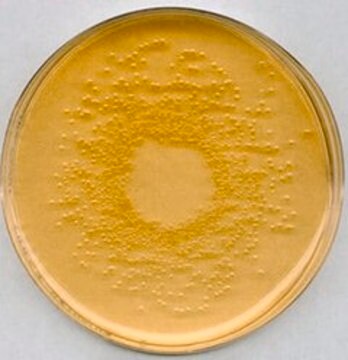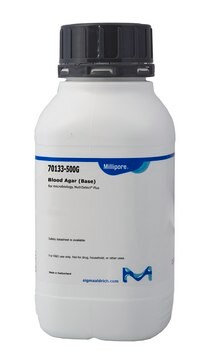15713
Universal Food pathogen ID Membrane
light pink colored, sterile, diameter 70 mm, suitable for microbiology
Sinónimos:
Indicator membrane, ID Membranes
Iniciar sesiónpara Ver la Fijación de precios por contrato y de la organización
About This Item
Código UNSPSC:
41171621
NACRES:
NA.85
Productos recomendados
membrane size
70 mm
esterilidad
sterile
caducidad
limited shelf life, expiry date on the label
condiciones de almacenamiento
protect from light
técnicas
microbe id | specific enzyme detection: suitable
aplicaciones
food and beverages
microbiology
temp. de almacenamiento
2-8°C
idoneidad
Bacillus spp.
Escherichia coli
Listeria spp.
Salmonella spp.
Shigella spp.
Staphylococcus spp.
coliforms
enterovirulent E. coli (EEC)
Descripción general
Universal Food pathogen ID Membranes are substrate-carrying membranes used for rapid identification and differentiation of food pathogens through characteristic color reactions by placing on the agar surface post-incubation. The membranes contain chromogenic substrates such as ONPG, X-Gal, or X-Glu, and other substrates and indicators, which serve as the basis for microbe differentiation by color. The target organisms possess enzyme systems that metabolize the substrates in the membrane, leading to a change of color. The colors can be visually detected on the membrane. This indicates microbial enzymatic activity which serves to identify the genus and species. This economical, confirmatory and rapid identification method is suitable for microorganisms from various food, dairy, fish, and meat products.
Aplicación
Universal Food pathogen ID Membrane is recommended for detection of food pathogens such as E. coli, E. coli O157:H7, Staphylococcus aureus, Salmonella, Bacillus, Listeria, and Shigella species, etc. from various food, dairy, fish, and meat products. They find their application in various sectors such as the water, food, and dairy industry.
Nota de análisis
Escherichia coli (25922)purpleStaphylococcus aureus (25923)golden yellowSalmonella Typhimurium (14028)colorlessBacillus cereus (10876)light green (big)Listeria monoyctogenes (19111)blue- greenEscherichia coli O157:H7 (NCTC 12900)purple pinkShigella flexneri (12022)colorless
Código de clase de almacenamiento
11 - Combustible Solids
Clase de riesgo para el agua (WGK)
WGK 3
Punto de inflamabilidad (°F)
Not applicable
Punto de inflamabilidad (°C)
Not applicable
Elija entre una de las versiones más recientes:
¿Ya tiene este producto?
Encuentre la documentación para los productos que ha comprado recientemente en la Biblioteca de documentos.
Peng Wang et al.
Current biology : CB, 27(21), 3278-3287 (2017-10-24)
The C
Johannes H Wilbertz et al.
Molecular cell, 73(5), 946-958 (2019-01-22)
Biological phase transitions form membrane-less organelles that generate distinct cellular environments. How molecules are partitioned between these compartments and the surrounding cellular space and the functional consequence of this localization is not well understood. Here, we report the localization of
Sofia Moreira et al.
Cell reports, 26(2), 293-301 (2019-01-10)
Apical-basal polarity is a common trait that underlies epithelial function. Although the asymmetric distribution of cortical polarity proteins works in a functioning equilibrium, it also retains plasticity to accommodate cell division, during which the basolateral determinant Lgl is released from
Lukas N Groschner et al.
Cell, 173(4), 894-905 (2018-05-01)
Perceptual decisions require the accumulation of sensory information to a response criterion. Most accounts of how the brain performs this process of temporal integration have focused on evolving patterns of spiking activity. We report that subthreshold changes in membrane voltage
Nuestro equipo de científicos tiene experiencia en todas las áreas de investigación: Ciencias de la vida, Ciencia de los materiales, Síntesis química, Cromatografía, Analítica y muchas otras.
Póngase en contacto con el Servicio técnico







